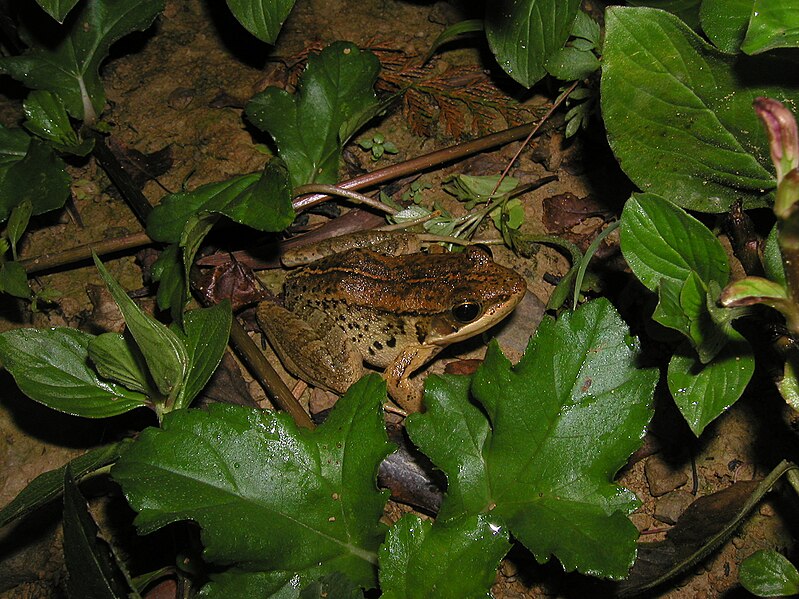 A recent study has challenged what we know, or thought we knew, about frog communication. Researchers were astonished to discover that the calls of male Emei Music Frogs, (Babina daunchina) inform females of such details as the length and width of the singer’s burrow.
A recent study has challenged what we know, or thought we knew, about frog communication. Researchers were astonished to discover that the calls of male Emei Music Frogs, (Babina daunchina) inform females of such details as the length and width of the singer’s burrow.
Construction Skills Needed
Named for the males’ banjo-like calls (they really do sound like banjos, please check video below), the Emei Music Frog is native to marshy habitats in central and southwestern China. Females deposit their eggs in burrows constructed by the males, and the tadpoles develop there as well. The ability to construct a safe burrow is, therefore, an important consideration when females go “mate shopping”. You can see photos of the unique nests and egg masses of a related species, Japan’s Ryuku Brown Frog, here.
Male Songs Contain Detailed Information
Researchers from the University of California and the Chinese Academy of Science analyzed the pitch, tone and other qualities of calls issued by different male Emei Music Frogs. They then observed females’ reactions to the different calls. Writing in a recent issue of Biology Letters (abstract below), biologists concluded that frog songs conveyed details about the burrow’s quality, including entrance width and depth! Also, males calling from within burrows received more female visits than those calling in the open (why take a chance on a suitor who may not have a burrow at all!).
From invertebrates to birds, females of various species physically inspect nests and other breeding structures constructed by males. Herpetologists theorize that evaluating the male’s call spares female frogs the time, energy and danger involved in actually visiting a breeding burrow.
Amphibian Dishonesty?
Given all the amazing new frog facts that have recently come to light (please see below), I’m moved to wonder if perhaps male Music Frogs might be capable of deceit and trickery. Do some insert “lies” into their calls, seeking to perhaps lure a naïve female who might then decide to stay (sort of like posting a 10 year-old photo of oneself on an online dating service!)?
In fact, an interesting form of sabotage is employed by American Bullfrogs. Females can gauge a potential mate’s size by the tone of his call. So can other males, apparently. Small males with no chance of attracting a female position themselves just outside the territories of large, desirable males. Known as “satellite males”, these industrious little fellows ambush females swimming in to mate with territory owners, hoping for a chance to procreate before the larger male notices what’s happening.
Other Surprises – Females Call while Mating
 The Emei Music Frog is not well-studied, yet in 2011 females were also found to exhibit a “frog first”. Experiments revealed that females call while in amplexus (please see photo of toads in amplexus), and that doing so apparently stimulates their partners to fertilize the eggs. Unpaired males also seem affected by female calls…in response, they sometimes invade the nest burrow and attempt to oust the owner!
The Emei Music Frog is not well-studied, yet in 2011 females were also found to exhibit a “frog first”. Experiments revealed that females call while in amplexus (please see photo of toads in amplexus), and that doing so apparently stimulates their partners to fertilize the eggs. Unpaired males also seem affected by female calls…in response, they sometimes invade the nest burrow and attempt to oust the owner!
Amphibian enthusiasts have recently been inundated with surprising discoveries and new-found species, including frogs that ambush birds, lack lungs and form lifelong pair bonds; even tree-dwelling, wood-eating tadpoles have been uncovered! Keep your eyes open, as well-studied groups are also yielding surprises – Mantellas were just found to utilize airborne pheromones, the only amphibians to do so.
Further Reading
Video: Emei Music Frog calling from burrow
Rana adenopleura image referenced from wikipedia and originally posted by Lai Wagtail
Amplexus image referenced from wikipedia and originally posted by Jeffrey Sciberras
 That Reptile Blog – Reptile, Amphibian and Exotic Pet Care and Information
That Reptile Blog – Reptile, Amphibian and Exotic Pet Care and Information


